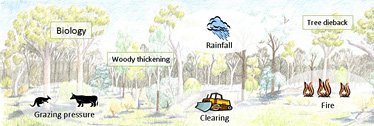Ecology


Understanding the ecology of eucalypt woodlands helps us to manage and restore these systems for carbon and wildlife.
The biology of woodland eucalypts
Woodland eucalypts produce seed every year, and fire is not needed to trigger the release of seed.
The seed survives for only a short period of time in the field, and most seed falls close to the parent tree (within about 2 or 3 times the height of the parent tree). This means that tree establishment may be limited or patchy if seed-bearing trees are scarce or absent.
Woodland eucalypts do not require fire, or the mass death of adult trees, for tree regeneration to occur. This means that a mature and self-sustaining eucalypt woodland will contain trees of different ages and sizes.
The seedlings of most woodland eucalypts develop a lignotuber within the first year of growth, and this increases their ability to survive fire and grazing.
Seedlings with lignotubers may survive for many years, with little increase in height, even if they are repeatedly grazed or burnt. In this way a ‘bank’ of small but persistent plants can become established, which can grow rapidly once conditions are more favourable.
The competition between woodland trees and grasses means that pasture yield tends to decrease as tree density and basal area increases.
When densities of woody plants increase in a woodland or pasture this is known as ‘woody thickening’. Woody thickening has traditionally been viewed in a negative light by Queensland pastoralists, because of corresponding declines in pasture yield.
The phenomenon of woody thickening demonstrates the ability of woodland trees and shrubs to establish in the presence of livestock grazing. This ability may help landholders who want to combine livestock production with carbon farming in eucalypt woodlands.
Low densities of big trees will hold more carbon than a thicket of small to medium-sized trees (see farming carbon). So it is in the interests of carbon farming to maximise the height and diameter of existing trees. This may involve selectively thinning smaller trees, or applying patchy, low severity fires to reduce sapling densities. Thinning also occurs when drought and competition among trees results in tree dieback.
Tree dieback
The dieback of woodland eucalypts means the death of all or part of the tree, and can have a number of causes.
Drought-related dieback appears to be more common in low-rainfall areas, while in other parts of Queensland, cycles of leaf loss and resprouting may be linked to tree clearing, insect damage, grazing, salinity and waterlogging.
It is difficult to prevent or manage drought–related dieback, but the second type of dieback may be less likely if shrubs and fallen timber are left to provide habitat for insect-eating animals.
Clearing
Tree clearing in woodlands can increase pasture yield, but soil nutrients often decline in cleared lands so that the initial gains in pasture production may not last over time.
In some eucalypt woodlands, the nutrient content of soils and the growth of pasture can be better under trees than further away.
Tree clearing may also reduce water infiltration, and increase water run-off and erosion. Therefore the combination of trees with pasture is likely to provide multiple benefits for carbon accumulation, pasture quality and soil health.
The retention of fewer, larger trees (rather than dense thickets of small trees) is the best option for maximising carbon (see farming carbon for more details), and this will also result in optimal pasture for grazing, plus the added benefits of microclimate changes, shade and protection for livestock.
In many cases, Queensland woodland eucalypts appear to regrow easily after clearing, provided that healthy trees are nearby to provide seed, rainfall is adequate and the soil surface has not been excessively degraded.
Fire
Woodland eucalypts can regenerate without fire, but fire may encourage the establishment of eucalypt seedlings.
Eucalypts can survive low to moderate intensity fires once a lignotuber is formed (which occurs 6 to 12 months after germination).
Fire has been used to control trees in eucalypt woodlands, as it keeps trees in reach of grazing animals, and this is known to limit tree growth. However, if an increased density of trees is desired for carbon farming, it makes more sense to suppress most fires, and use grazing to manage fuel loads.
Fires (of moderate-severity to high-severity and above) will also consume fallen timber and will tend to topple large trees, especially those with hollows, reducing carbon stocks and removing important wildlife habitat.
Grazing pressure
High levels of grazing pressure can lead to reduced eucalypt recruitment and growth, and increased soil degradation.
However, in many situations, eucalypt regrowth is not prevented by grazing animals.
This means that carbon farming in many eucalypt woodlands should be compatible with light to moderate grazing pressure.
Rainfall
The establishment of eucalypt seedlings, particularly in drier areas, can be episodic and related to rainfall patterns.
Extended drought may also cause dieback and/or death of trees, and will certainly slow growth and make reforestation difficult.
In areas without young regenerating eucalypts already present, reforestation may depend on a good supply of viable seeds, and adequate follow-up rain for their germination and establishment.


